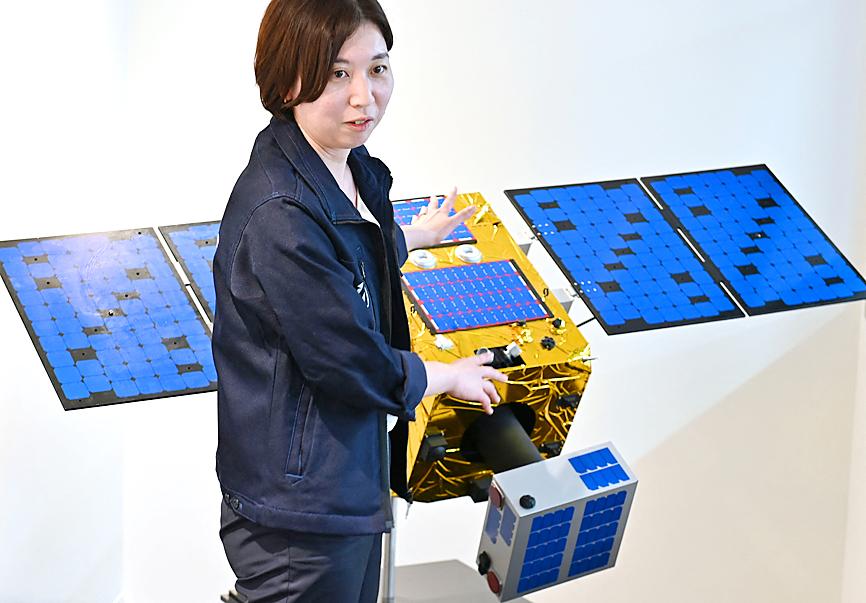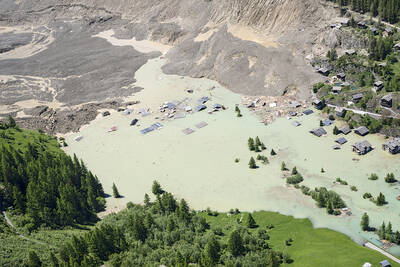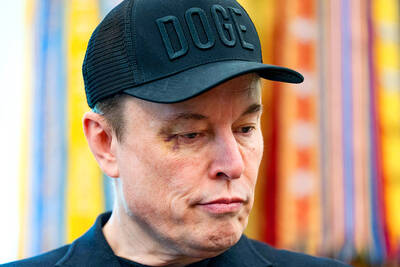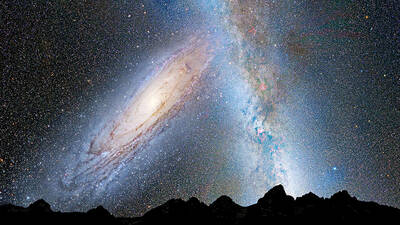From laser beams and wooden satellites to galactic tow-truck services, start-ups in Japan are trying to imagine ways to deal with a growing environmental problem: space debris.
Junk such as used satellites, rocket parts and wreckage from collisions has been piling up since the space age began, with the problem accelerating in the past few decades.
“We’re entering an era when many satellites will be launched one after another. Space will become more and more crowded,” said Miki Ito, general manager at Astroscale, a company dedicated to “space sustainability.”

Photo: AFP
“There are simulations suggesting space won’t be usable if we go on like this,” she said. “So we must improve the celestial environment before it’s too late.”
The European Space Agency (ESA) estimates that about 1 million pieces of debris larger than a centimeter — big enough to “disable a spacecraft” — are in Earth’s orbit.
They are already causing problems, from a near-miss in January involving a Chinese satellite, to a 5mm hole knocked into a robotic arm on the International Space Station last year.
“It’s hard to predict exactly how fast the amount of space debris will increase,” said Toru Yamamoto, a senior researcher at the Japan Aerospace Exploration Agency (JAXA).
“It’s an issue that raises real concerns about the sustainable use of space,” he said.
With satellites now crucial for GPS, broadband and banking data, collisions pose significant risks on Earth.
Tadanori Fukushima said he has seen the scale of the problem in his job as an engineer with Tokyo-based satellite operator and broadcaster SKY Perfect JSAT.
“A stationary satellite would get roughly 100 ‘debris-approaching’ alerts a year,” he said.
International “satellite disposal guidelines” include rules like moving used satellites to “graveyard orbit” — but the increase in debris means more is needed, specialists say.
Fukushima launched an in-house start-up in 2018 and envisions using a laser beam to vaporize the surface of space debris, creating a pulse of energy that pushes the object into a new orbit.
The irradiating laser means there is no need to touch any debris, which is generally said to move about 7.5km per second — much faster than a bullet.
For now, the project is experimental, but Fukushima hopes to test the idea in space by spring 2025, working with several research institutions.
Japanese firms, along with some in Europe and the US, are leading the way on developing solutions, Fukushima said.
Some projects are further along, including Astroscale’s space “tow truck,” which uses a magnet to collect out-of-service satellites.
“If a car breaks down, you call a tow-truck service. If a satellite breaks down and stays there, it faces the risk of collision with debris and needs to be collected quickly,” Ito said.
The firm carried out a successful trial last year and hopes to eventually equip customer satellites with a “docking plate” equivalent to a tow-truck’s hook, allowing collection later on.
Astroscale, which has a contract with the ESA, plans a second test by the end of 2024 and hopes to launch its service soon after.
Other efforts approach the problem at the source, by creating satellites that do not produce debris.
Kyoto University and Sumitomo Forestry envisage a wooden satellite that goes into orbit in a rocket and burns up safely when it plunges to Earth.
That project is also in its infancy — in March, pieces of wood were sent to the International Space Station to test how they respond to cosmic rays.
Space agencies have their own programs, with JAXA focusing on large debris greater than three tonnes.
Internationally, firms including US-based Orbit Fab and Australia’s Neumann Space have proposed ideas such as in-orbit refueling to extend the life of satellites.
The problem is complex enough that a range of solutions will be needed, Yamamoto said.
“There is no panacea,” he said.

The collapse of the Swiss Birch glacier serves as a chilling warning of the escalating dangers faced by communities worldwide living under the shadow of fragile ice, particularly in Asia, experts said. Footage of the collapse on Wednesday showed a huge cloud of ice and rubble hurtling down the mountainside into the hamlet of Blatten. Swiss Development Cooperation disaster risk reduction adviser Ali Neumann said that while the role of climate change in the case of Blatten “still needs to be investigated,” the wider impacts were clear on the cryosphere — the part of the world covered by frozen water. “Climate change and

Poland is set to hold a presidential runoff election today between two candidates offering starkly different visions for the country’s future. The winner would succeed Polish President Andrzej Duda, a conservative who is finishing his second and final term. The outcome would determine whether Poland embraces a nationalist populist trajectory or pivots more fully toward liberal, pro-European policies. An exit poll by Ipsos would be released when polls close today at 9pm local time, with a margin of error of plus or minus 2 percentage points. Final results are expected tomorrow. Whoever wins can be expected to either help or hinder the

DENIAL: Musk said that the ‘New York Times was lying their ass off,’ after it reported he used so much drugs that he developed bladder problems Elon Musk on Saturday denied a report that he used ketamine and other drugs extensively last year on the US presidential campaign trail. The New York Times on Friday reported that the billionaire adviser to US President Donald Trump used so much ketamine, a powerful anesthetic, that he developed bladder problems. The newspaper said the world’s richest person also took ecstasy and mushrooms, and traveled with a pill box last year, adding that it was not known whether Musk also took drugs while heading the so-called US Department of Government Efficiency (DOGE) after Trump took power in January. In a

It turns out that looming collision between our Milky Way and Andromeda galaxies might not happen after all. Astronomers on Monday said that the probability of the two spiral galaxies colliding is less than previously thought, with a 50-50 chance within the next 10 billion years. That is essentially a coin flip, but still better odds than previous estimates and farther out in time. “As it stands, proclamations of the impending demise of our galaxy seem greatly exaggerated,” the Finnish-led team wrote in a study appearing in Nature Astronomy. While good news for the Milky Way galaxy, the latest forecast might be moot